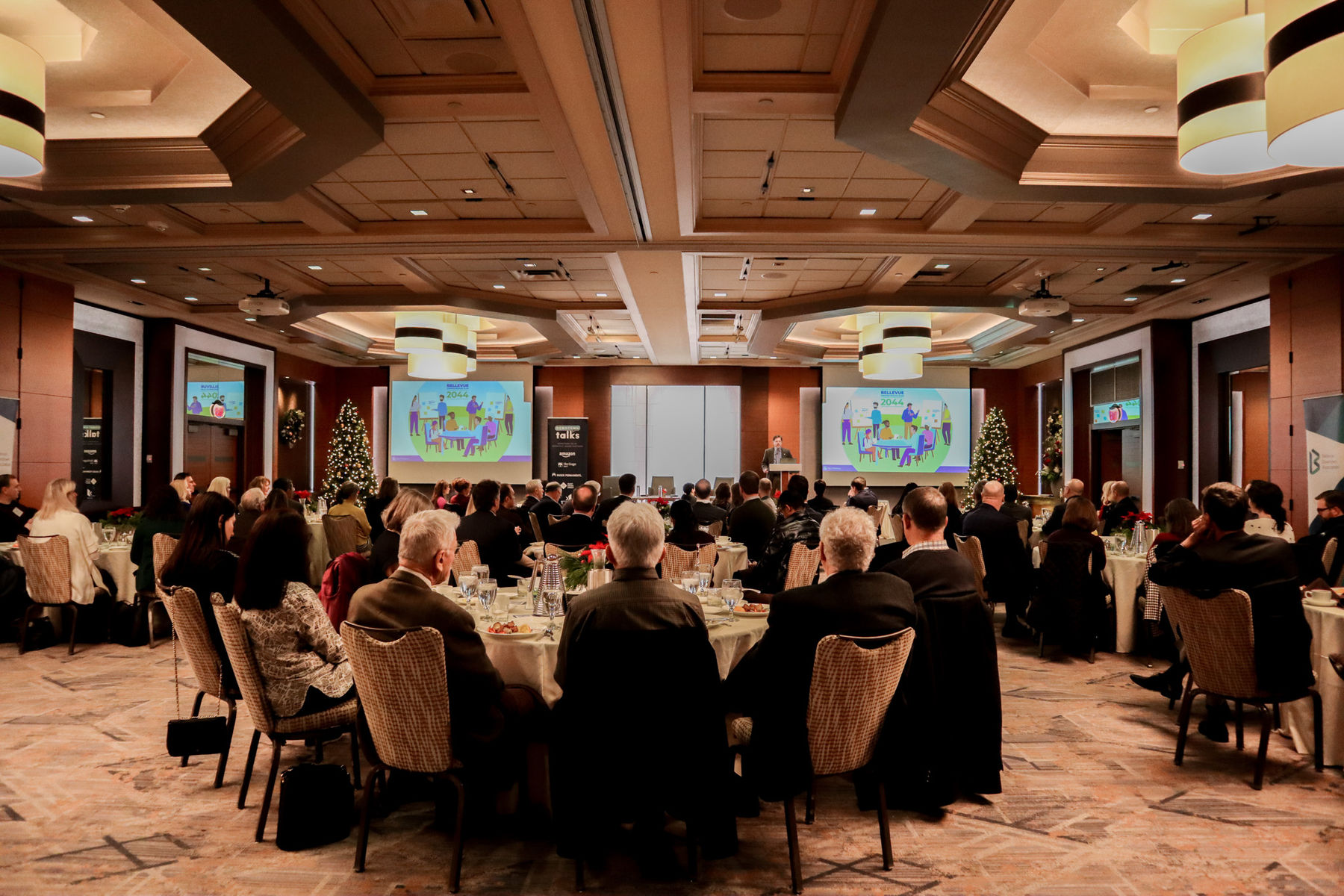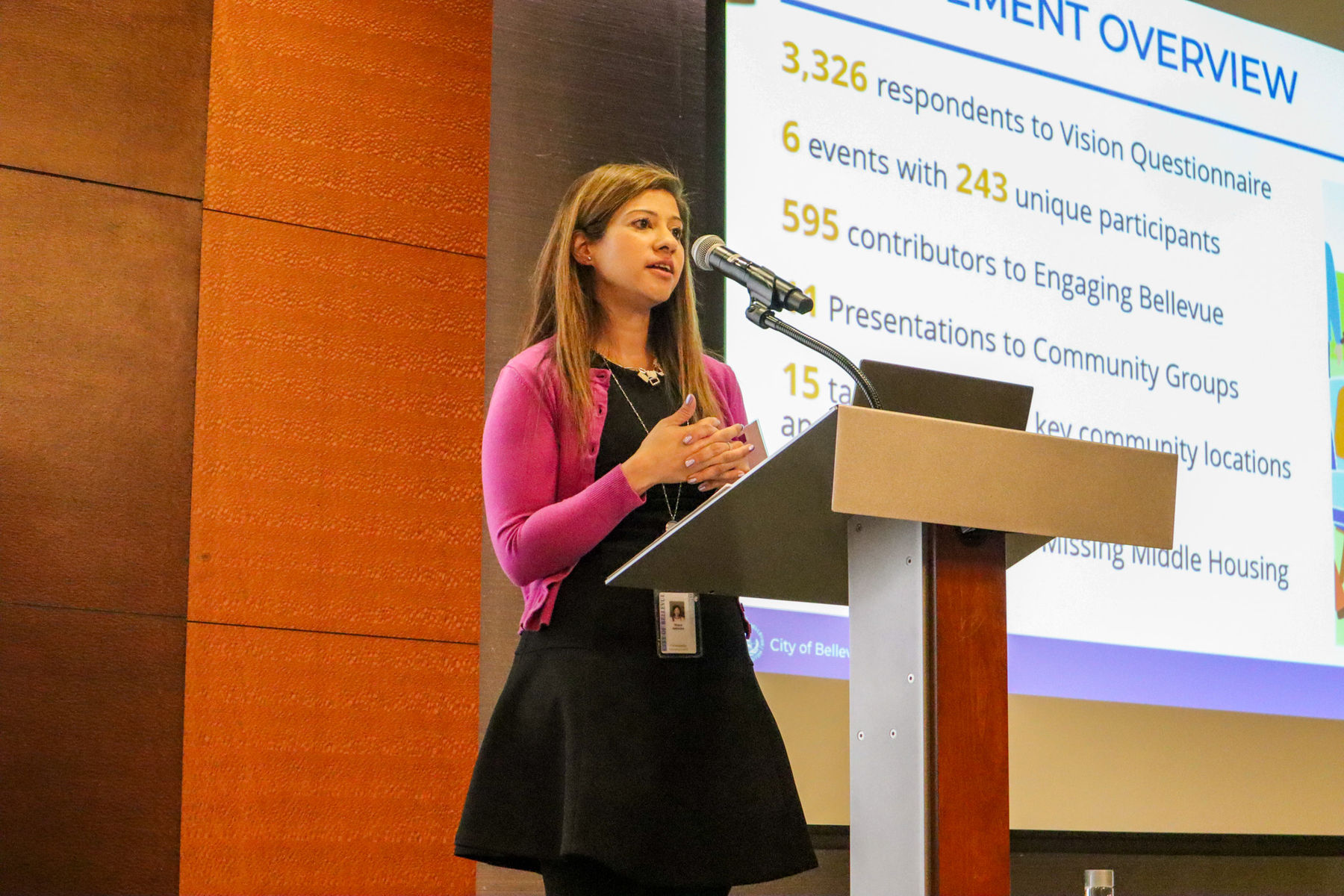Charting the Future: City of Bellevue's Plan for the Next 20 Years
December 15, 2022
Charting the Future: City of Bellevue's Plan for the Next 20 Years

The City of Bellevue's 2024 Team gave us a glimpse into the future at our last Downtown Talks Breakfast of the year. On Tuesday, attendees received insight into the City of Bellevue's Comprehensive Plan, where they addressed anticipated needs for the next 20 years and what it will take to maintain a high quality of life and experience for Bellevue's residents, businesses, workforce, and visitors. Speakers included Deputy City Manager Diane Carlson, Director of Community Development Michael Kattermann, Planning Director Emil King, and Comprehensive Planning Manager Thara Johnson.
Here's what we learned
The Comprehensive Plan is split into two volumes. Volume One covers land use, housing, transportation, and capital facilities while volume two focuses on the subareas and neighborhoods in the city outside of Downtown. This massive effort to coordinate a thorough, responsive Comprehensive Plan will rely on public engagement and input from the business community, developers, property owners, city council, boards, and commissions. As we're coming up on the 70th anniversary of the City of Bellevue's incorporation in 1953, King states he believes this is the most critical update the city has undertaken.
Bellevue is faced with a lot of opportunities and challenges. The four-county region, including King County and Bellevue, is projected to grow by another 1. 8 million people between now and 2050 and another 1. 2 million jobs over that same period. Both the region and the city face significant housing supply and affordability issues that will worsen with the projected growth. The Comprehensive Plan will address the housing needs by studying different scenarios to help answer the question "how much additional housing will be needed to accommodate the drastic growth?" The regional planning framework calls for a minimum of 35,000 additional housing units between 2019 and 2044 and a minimum of 70,000 jobs over that same period. Currently, they are wrapping up the Environment Impact Statement EIS for growth alternatives, laying out four housing capacity options. Option one is keeping at our current total of 30,000 housing units. Additional options go from 45,000 to 50,000, up to 65,000 to 70,000.
As the housing and population growth discussion continues, it's worth noting that 85% of the citywide job growth and roughly 70 to 80 percent of housing growth is within Bellevue's Growth Corridor: Downtown, East Main, BelRed, and Wilburton. To address needs in those areas, the plan will continue to explore different land use alternatives to address the needs of those communities.
Additional updates to the plan incorporate equity and inclusion from a process standpoint: who is involved, and who has access to opportunities? While Bellevue has already made great strides in sustainability and resiliency, the plan would allow the city to be more thoughtful in its environmental work. King noted that the current comprehensive plan includes the Great Place Strategy, which states that "Downtown Bellevue must be a viable, livable, memorable, and accessible place. It must become the symbolic and functional heart of the Eastside region through the continued location of cultural entertainment, residential, and regional uses. These must be in distinct mixed-use neighborhoods within downtown, connected by various unique public places and excellent infrastructure." While this was written many years ago, the statement still rings true to the current work of the Bellevue Downtown Association (BDA) and the continued direction of Bellevue’s growth.
Gathering Feedback From the Community
Community input helps paint a picture of the types of buildings, typology, and locations the City currently has, and that community stakeholders desire. It also guides policy changes to assist with commercial affordability and future gathering spaces downtown and in neighborhoods throughout the city.

Johnson has been surveying the community on what people value for the future growth of Bellevue since February of this year. Through the city’s engagement efforts, they received more than 3,800 responses from questionnaires, hosted six events, presented to 11 community groups, set up an information table at 15 events in crucial community locations and neighborhood gatherings, and received 595 contributions from outreach from their Engaging Bellevue website. Surveys focused on various issues, including housing, land use, transportation, utilities, parks, and economic development. To ensure all communities were properly represented, cultural liaisons were used to support local groups from all backgrounds.
In addition to the data, the Bellevue 2044 Strategy Team met on eight occasions. They hosted focus groups featuring the voices of more than 40 community stakeholders, from business, developers, arts, human services, and education to neighborhood leaders.
Here's what they've learned:
- Emphasis on placemaking, creating more areas focused on activity, arts, and entertainment.
- Improving existing neighborhood centers and finding new locations for small retail centers in neighborhoods
- Supporting more mid-rises and diverse business development around downtown
- More infrastructure and more options for multi-modal types of transportation to help cut down traffic and provide easy access to destinations downtown and shopping/retail centers
- Housing affordability remains a top concern More support for mixed middle housing zones, giving more opportunities for family housing and more workforce housing
All work for the update must be done by December 2024. There will be at least two to three more public meetings to discuss the draft alternatives’ impacts, followed by a 30-day comment period for the community to weigh in on the decision.
Results from our Downtown Talks
Attendees were given an opportunity to share their thoughts with the Bellevue 2044 Team and with each other on these two questions:
- What three words would you use to describe the future of Bellevue?
- What is one thing you want the team to know about your hopes for the future of Bellevue?
“This community as a whole, but especially downtown, will need to remain people-centered and focused on the experiences that people now and, in the future, will want to have,” said BDA President Patrick Bannon after sharing the results submitted by attendees.
These answers help to guide us all toward a shared vision. We were inspired by the possibilities of where the future of Bellevue could take us. Your voice remains a vital part of shaping downtown’s future. Stay involved with the Bellevue 2044 process by registering to receive updates on the planning process and invitations to participate.
Sign up to receive updates on Downtown Talks and event details.





